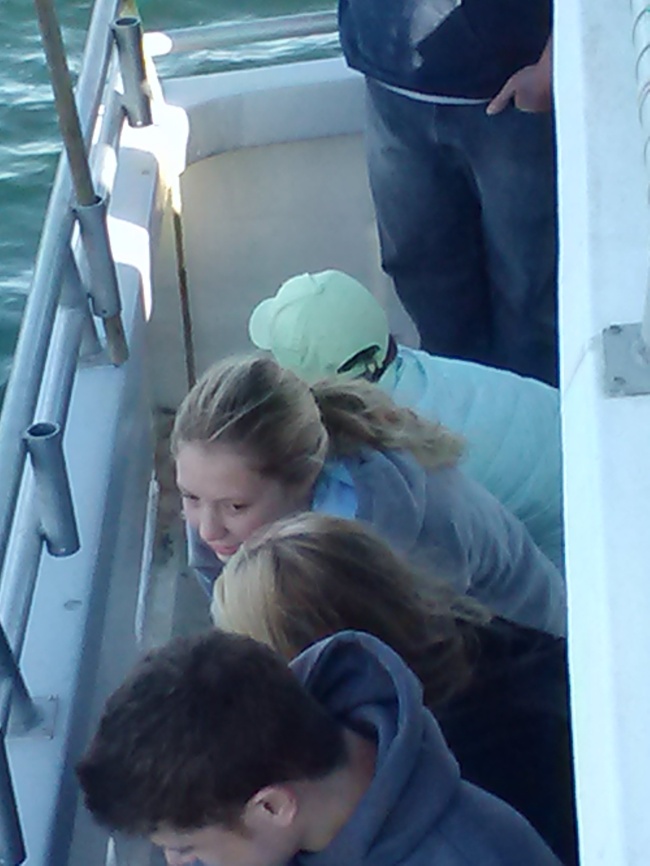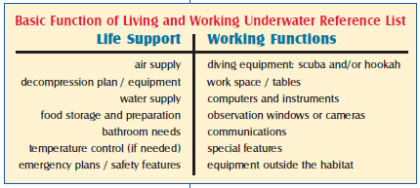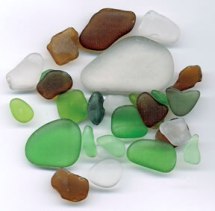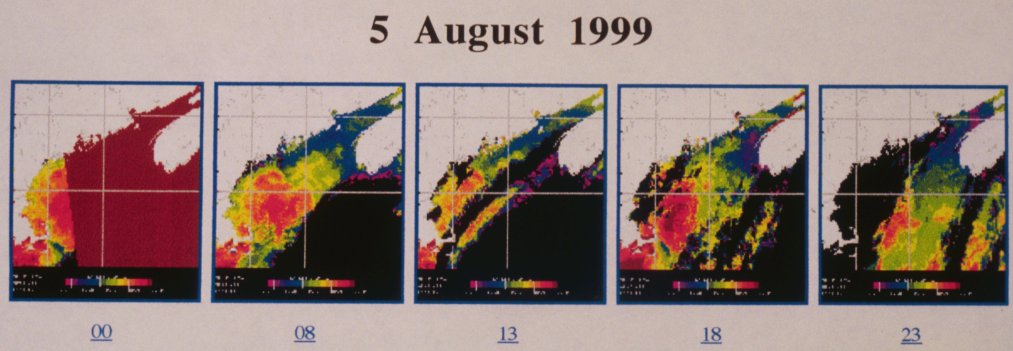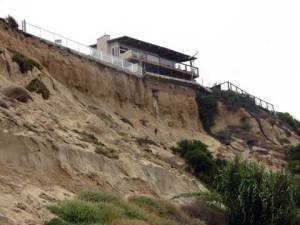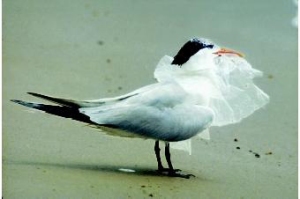Students in Oceanography class, which is taken by high school juniors and seniors, were assigned a research topic with presentation for their final assignment. Presentations, given by the students during their final exam period, were a wonderful wrap-up to oceanography and segue to marine biology next semester. Their presentations also provided a means for covering a lot of ocean resource topics in a short time period, as each student was assigned a different resource, but all with the same essential question:

The assignment
Big Idea: The ocean and humans are inextricably interconnected. The oceans are a connected system of water in motion that transports matter and energy around Earth’s surface.
Assignment: In the role of a marine scientist, you will research a marine resource and present an argument for a position related to use of that resource, supporting your position with scientifically valid evidence.
Product: On the day of the final exam you will (1) turn in a 3- to 5- page paper, and (2) give a five- to ten-minute oral presentation, with video support, of your research results.

Commercial Fisshing slide by Jesse
Marine Resource Topics:
To make sure that each student had a separate research topic, I printed the following list in large font and spread them out on the table for students to choose from. Sometimes I assign by putting the topics in a “hat” and students choose blindly, but this is typically followed by a lot of negotiations for swapping; the way I did it this time still had negotiations, but between only those that were quickest with the grab rather than everyone. No perfect way to do this because everyone wants coral reefs.
- Petroleum and natural gas
- Marine sand and gravel
- Magnesium and magnesium compounds
- Salt
- Manganese Nodules
- Phosphorite Deposits
- Metallic Sulfides
- Fresh Water from the Ocean
- Methane hydrates
- Offshore wind energy
- Energy from waves and currents
- Energy from ocean vertical thermal gradient
- Coastline protection
- Coral Reefs
- Medicine and drugs
- Crustaceans and molluscs
- Commercial fishing practices
- Aquaculture
- Whaling
- Managing biological resources
Students were encouraged to narrow down their topics to make them more manageable. For example, “Aquaculture” could be narrowed down to shrimp farming.
To make the assignment clear to the students, I broke the description into two pages: the paper and the presentation.
Research Guidelines:

Wave Energy by Jacob
1.Required Length: 1000 words (approximately three pages of text), not including references and not including quoted material.
2. Required references: a minimum of five relevant scientific articles and/or internet sites related to the topic. This is the minimum amount of reference material — you may need more to do an adequate job of researching your topic.
3. Things to focus on in your research:
- define the problem – what part of the world’s ocean does it affect?
- how did the problem come about? How is the problem being made worse by humans/is it being made worse by humans? What are the various causes of the problem?
- what are some possible solutions to the problem? Are any of the feasible? How will we implement some of these solutions?
- what is the importance or significance of the topic?
- what methods have scientists used to investigate the topic?
- what kinds of information and data have scientists found?
- what major results and conclusions have scientists made, based on the above?
4. Format of the paper:
- Lead off with a separate title page, containing: title, your name, course name, school name, date
- Body of at least three pages of text (~1,000 words):
- Begin the body with an introduction: a section (one or two paragraphs) that clearly states the purpose of the paper and reviews the main points that the paper will cover
- Break up the paper into logic sections using subheadings to identify the subject of the different sections
- End the paper with a conclusion (one or two paragraphs) that wraps up and summarizes in specific ways the main points of the paper
- Spell-check and grammar-check! (sloppy spelling errors and poor grammar will result in a poor grade)
- A page (or more) of references per MLA guidelines
5. Submitting your paper: Submit your paper in electronic format, preferably in Microsoft Word or Google doc.
6. Plagiarism: Don’t. Just don’t. You know better.

Background and Reflective Thoughts
Our school only teaches MLA formatting. With my 18-year background of writing engineering documents, I find it frustrating to constantly be getting english-style essays rather than scientific documents. Starting next year, I plan on teaching my students APA formatting, and directing students to understand the difference between technical writing and english-essay writing.
The word length is only 1000 words because I wanted the students focussed on finding good resources and highlighting the issues, rather than being focussed on “getting the right number of words”. In meeting the research requirements most students were concerned that they had gone too far over the minimum.
Our librarian has stacks of research record templates in different colors for students to use to document their research, with teachers assigning a different color for the type of resources, e.g., blue for a book, green for technical article, etc.. Our librarian has, for her entire career here, been proactive in helping students to learn the difference between “good” and “bad” resources, to understand what paraphrasing is and isn’t, and to use databases beyond the internet. She teaches all freshmen how to research a topic and has written a research guide for students.
-
A coral reef is the rainforest of the ocean with all its diversity.” – Sam
Presentation Guidelines:
You may use the board, posters, handouts, or a PowerPoint presentation to help provide visual aids. Following your presentation, there will be time for a few questions. You should know your topic well enough to answer all reasonable questions on the topic. Grades will be based on both what you present and how well you know the information.
If you just read a few paragraphs directly from a sheet of paper or from your slides and cannot answer basic questions on your topic without your notes, you should not expect a passing grade on the presentation.
You have studied many physical aspects of the ocean. Include a detailed discussion of at least one of these in your paper and presentation. They include:
- Understand and describe some important properties of water: Before we can understand the numerous and amazing ways the oceans impact our lives on land, we need to understand some special qualities of water. Properties such as surface tension, capillary action and solvency make water one of the most unique substances on Earth.
- Explain how waves form and shape the coastline. Understanding conditions on the shore will help us understand some ocean habitats.
- Describe the differences between wave and current formation and qualities.
- Explain how ocean currents influence climate on land.
- Describe and identify ocean floor features Understanding the shape of the ocean floor will help us understand ocean habitats.
- Analyze different ocean zones of life and categorize organisms that live in each.
Background and Reflective Thoughts
I enjoyed the student presentations and really wish I had thought to video tape them. To make sure that students were paying attention to other presentations, they were given a sheet of paper to record thoughts and impressions, and this paper was collected:
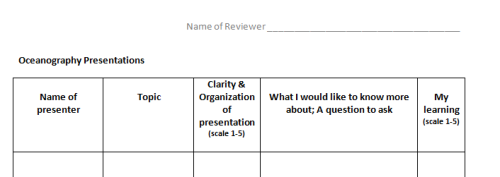
I was inspired by many of the presentations and it gave me the idea that, in my mixed CP/Honors Marine Biology class next semester, the honors students (who will have work in addition to the rest of the class) should give presentations to the CP students.
A couple of closing thoughts from the students:
-
“Fishing to extinction of species is evolution going in the wrong direction.” – Josh
-
“You never think about not having earth’s resources until you do not have them anymore, but by then it is too late. Everyone must be mindful of Earth’s natural resources because so we do not find out one day that they’re all gone. ” – Kelsey
Amen to that.














